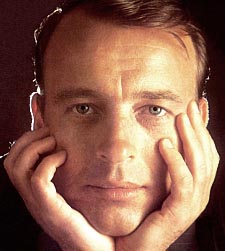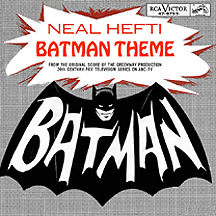NEAL HEFTI
Batman Theme
Batman first appeared in the May 1939 issue of Detective Comics, issue number 27, the brainchild of comic artist Bob Kane (with some help from writer Bill Finger). It's quite an accomplishment for a fictional super hero to still be going strong after 100 years, but Batman is one such creation (I'm jumping ahead, I know, but at the rate he's going, the Caped Crusader is sure to hit that milestone anniversary with ease). There was a time, about 20 years after his debut, when the future of Batman and his ever-teen sidekick Robin was uncertain, and at one point in the early 1960s, publisher DC Comics considered retiring the character and canceling the comics titles that featured Gotham City's protector. Wisely, they didn't, and at the beginning of 1966 when ABC premiered the Batman TV series, the entire nation went Bat-crazy!
When those early issues of Detective Comics were hitting the newsstands and drug store racks, Neal Hefti was 16 years old and already accomplished as a trumpet player at his high school in Omaha, Nebraska. By 1942 he had moved to New York City and secured a spot in Charlie Barnet's big band, shortly after joining the Charlie Spivak band (oddly, both Charlies were having temporary downturns, hit-wise, when Hefti was with them). He followed with brief stints in the Horace Heidt and Harry James bands, then moved into a more permanent position with Woody Herman, doing trumpet arrangements for his outfit. He married Woody's vocalist Frances Wayne in 1944 and when starting his own band a few years later, she left Herman to join her husband. More interested in jazz than big band styles while growing up, Neal jumped at the chance to work as an arranger for Count Basie during the '50s. Their decade-long association peaked in 1958 with the Roulette Records release Basie (with its ominous nuclear blast cover photo, it's often referred to as the "Atomic" album), entirely written and arranged by Neal, which includes the now-classic "Lil' Darlin'." At the first Grammy Awards ceremony on April 4, 1959, the album picked up wins in the categories of Best Jazz Performance, Group and Best Performance by a Dance Band.
In 1962 Hefti hooked up with Frank Sinatra, arranging and conducting Sinatra and Swingin' Brass, a top-selling album. Frank's and Neal's contribution to the hot "Twist" trend of the time, "Ev'rybody's Twistin'," was recorded at the session but omitted from the album, released instead as a single. In the mid-'60s Neal established an impressive track record scoring movie soundtracks, including Sex and the Single Girl (1964), How to Murder Your Wife (1965), the '66 films Lord Love a Duck and Duel at Diablo, Barefoot in the Park (1967) and the '68 hit The Odd Couple. Right in the middle of all these high-profile assignments came the one thing he would be most remembered for.
In the early-'60s, ABC-TV had some interest in doing a Saturday morning children's show based on the Batman comics, but nothing had materialized. Hugh Hefner, a fan of movie serials since childhood, began showing Columbia Pictures' 15-chapter 1943 Batman serial (and its 1949 sequel, Batman and Robin) at the Chicago Playboy Club and the screenings were extremely popular, prompting the studio to rerelease the serials, which played around the country in 1965 to packed houses of mostly-adult moviegoers. When ABC caught wind of what was happening, they hired Greenway Productions to produce a prime time series. Originally planned as a serious crime/adventure show, it soon became clear how difficult that would be to pull off on a live-action series (the serials had fallen short in that respect as well), so they decided to do it as a "camp" comedy, similar to but more extreme than what the Adventures of Superman show had evolved into during its 1952-1958 run, though the later Green Hornet series succeeded, for the most part, at "playing it straight."

The show's producer, Greenway exec William Dozier, contacted Hefti to compose the theme song. The result was a quirky cross between Hefti's jazz influences and the surf and spy instrumental hits of the era, with a four man, four woman chorus singing the tune's one-word lyric: 'Baaat-maaan!!!' The series premiered on Wednesday, January 12, 1966 with two episodes per week (a tactic begun with the prime time Peyton Place in the fall of '64). Each Wednesday's episode ended with Batman and Robin (Adam West and Burt Ward) in a dire cliffhanger situation (resolved at the beginning of Thursday's installment), much like the standard format of the popular serials of the 1930s and '40s. Ratings went through the roof as the viewing audience found itself caught in the grip of "Batmania." Sales of the comics tripled that year (not only Batman, but comics in general reaped the benefits of greatly increased sales) and Batman-related items flew off the shelves: toys, games, model kits, bubble gum cards, lunch boxes, dolls, costumes of Batman, Robin, the Joker and other characters from the show...the list goes on and on.
I can come up with a few Batman musical pieces that predate the television theme: first, the '40s serials had opening theme songs (by Lee Zahler and Mischa Bakaleinikoff, respectively) and surf band The Astronauts recorded a tune called "Batman" in 1963. But it was Hefti's "Batman Theme" in 1966 that became the pinnacle of Bat-concertos fondly remembered through the years. RCA Victor released a single of the theme, which entered the charts a few weeks after the series debuted, hitting the top 40 in March while a quickly-thrown-together cover by The Marketts went even higher, going top 20 at the same time. Literally dozens of other versions flooded the market. Some of them were quite good (or at the very least came across as interesting curiosities): Al Hirt, Link Wray, The Ventures and The Who got in on the act, as well as Nelson Riddle, who was chosen over Hefti to perform the music used on the actual show. In fact, besides Neal's "Theme" and "Batman Chase," a variation on the theme, none of his other compositions were used on the series (even though RCA released not one, but two albums chock full of Hefti Bat-songs)! No matter, since in the long run it was his theme song that got all the exposure, lasting far beyond the series' three seasons.
Other Batman songs appeared as the music industy's obsession increased in proportion to the show's rapid growth: Jan and Dean's "Batman" and Peggy Lee's "That Man," followed by Dickie Goodman's inevitable "break-in" comedy sendup, "Batman and his Grandmother," all rode the charts that spring. LaVern Baker even added her two cents with "Batman to the Rescue," loosely based on her 1957 hit "Jim Dandy," and Frank Gorshin took advantage of his own claim to Bat-fame with a "riddle me this!" novelty single called, appropriately, "The Riddler." During the show's third season when Yvonne Craig was added to the cast playing Batgirl, Billy May composed the "Batgirl Theme," used on the series as an intro whenever she appeared, though the song was never released on record.
The series, and the song, continued to dominate in 1967; Neal's "Batman Theme" received three Grammy nominations, winning at the March 2 ceremony in the category of Best Instrumental Theme. Just one year later, the TV series ran out of steam and was canceled by ABC, leaving us with a plentiful 120 episodes in syndication and, starting in 1989, the Batman film franchise that's still going strong, supplemented by an animated series from 1992 through '95. The Batman legend just keeps growing and the mania continues for millions, if not billions, of fans worldwide. I have no doubt that the Caped Crusader's 100th anniversary in 2039 is destined to be a big event and Neal Hefti's musical milestone will be in the air, everywhere.


